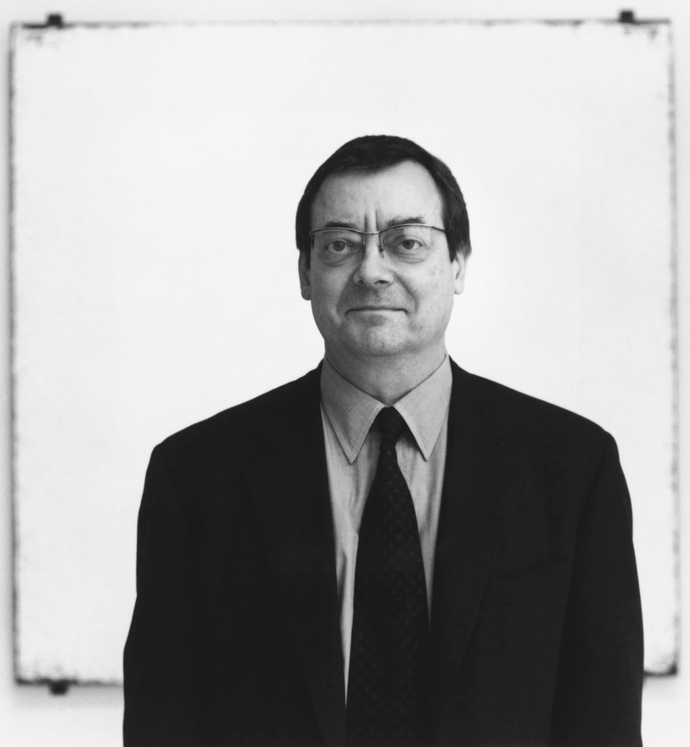
Robert Ryman
Robert Ryman is regarded as one of the most important American artists to emerge after World War II. Identified as a Minimalist, his paintings, predominantly white and typically square, display a remarkable diversity that defies strict Minimalist characteristics.
Biography of Robert Ryman
Robert Ryman was born in Nashville, Tennessee, in 1930, and trained as a jazz saxophonist. After moving to New York to study under jazz pianist Lennie Tristano, Ryman played hard bebop, inspired by Charlie Parker and Zoot Sims. He took a museum job to support himself and worked as a guard at the MoMA for seven years, starting in 1952 after he relocated to the city.
During his time at MoMA, he not only became acquainted with the works of abstract expressionist painters but also formed connections with fellow part-time museum guards, including Sol LeWitt, Dan Flavin, and Al Held. All later became associated with minimal art in the early 1960s, although Ryman insisted he was not part of any artistic movement. In 1961, the artist married critic and curator Lucy Lippard, but they divorced a few years later. He also became acquainted with Eva Hesse and other artists in the downtown scene.
Ryman initiated his painting endeavors in his apartment in the mid-1950s. Despite receiving minimal formal artistic training, he dedicated himself to learning the art of painting through hands-on experimentation. His earliest works from the late 1950s and early 1960s showcased his intense fascination with the quality of paint and the surfaces he created through varied facture. Contrary to his reputation as a painter solely interested in white, Ryman also explored the interplay between chromatic and achromatic tones. Many of his paintings from the 1980s expanded into the viewer's space through unconventional support structures or materials, challenging the traditional interaction between the viewer and the artwork.
In 1967, Ryman had his inaugural solo exhibition at the Paul Bianchini Gallery on upper Madison Avenue, showcasing 13 "Standard" paintings executed in enamel on cold-rolled steel. In 1968, he began exhibiting in Europe, where his work was frequently featured in museum exhibitions.
A notable highlight of Ryman's career was being the sole painter included in two major overviews of Conceptual Art and Post-Minimalism during the spring of 1969. These exhibitions were "When Attitudes Become Form" at the Kunsthalle Bern in Bern, Switzerland, and "Anti-Illusion: Procedures/Materials" at the Whitney Museum of American Art in New York.
Ryman's first American retrospective took place at the Guggenheim Museum in 1972. In 2015, the Dia Art Foundation organized another retrospective at its Chelsea branch in Manhattan, further cementing his legacy in the art world.
Robert Ryman's Art Style
Throughout his career, Robert Ryman's focus remained as much on the materiality of painting as on image-making, which appeared to be a consequence of the process and a series of deliberate actions. The material was a matter of sheering and adhering surfaces, using lacquer or casein-based paints, oils, and acrylics on wood, paper, canvas, or metal. He explored gloss and matte textures, thickness and thinness, uniformity, and textural variation. He cultivated his fields of white, carefully inspecting their borders with his brush and discerning eye.
Ryman meticulously explored the nuances of white color, examining the diverse shades and tones produced by various paints and pigments. He experimented with different materials, including lead, zinc, barium, and titanium, to create an array of whites, such as chalky, industrial, silky, bone, kitchen, shroud, numinous, and dead whites. He was fascinated by the diverse qualities of opacity, depth, brilliance, and dullness present in each shade and how they could be perceived differently depending on the surface they were painted over, the application method, and the binder. The amount of dilution also played a vital role in the outcome of the color.
Ryman is widely acclaimed for his tactile creations using white paint in its myriad forms. He employed various painterly mediums on diverse surfaces, including paper, canvas, linen, aluminum, vinyl, and newsprint.
Years:
Born in 1930
Country:
United States of America, Nashville